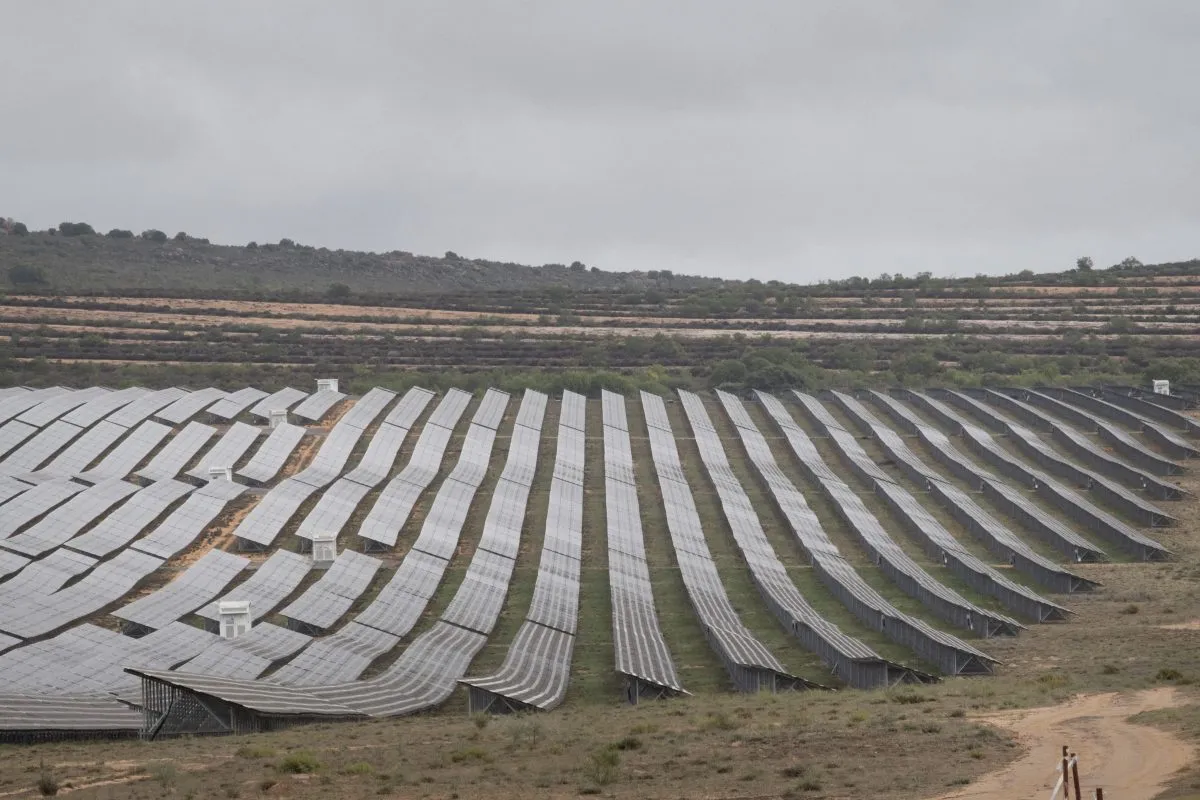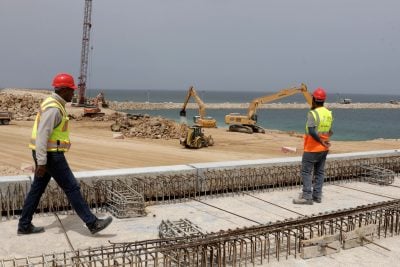For South Africa’s new government of national unity (GNU), there is no more urgent or obvious priority than fixing the country’s energy system. Years of increasingly dire power outages, known locally as “load-shedding”, have brought the South African economy to its knees. These semi-planned blackouts sometimes leave households without power for several hours per day. Estimates of their economic impact vary widely: consultants PWC say they likely reduced potential real GDP growth by five percentage points in 2022. The South Africa Reserve Bank predicts that they will cut 0.6 percentage points from GDP growth this year. The frustration and inconvenience incurred by South Africans are almost impossible to calculate.
Load-shedding has eased considerably since the beginning of 2024. Maintenance problems at the country’s power stations have abated, at least temporarily, while the rapid installation of rooftop solar panels has reduced pressure on the grid.
Nevertheless, the failure to ensure a reliable power supply has been perhaps the single largest reason why the African National Congress has lost popular support. After 30 years of ANC rule, voters’ patience has run out. Many business leaders were nervous, however, that the elections could lead to radical factions entering government and seizing control of energy policy.
The 29 May election and subsequent coalition negotiations ultimately produced both continuity and change. The ANC continues to lead the government and has retained the key ministerial portfolios that shape energy policy. However, a reshuffling of departmental responsibilities, combined with the entry of the centre-right Democratic Alliance and other smaller parties into government, offers hope that a reformist agenda can take shape.
Nightmare averted
From an investor perspective, there was a real risk that the election could bring a populist shift that would greatly restrict market-based solutions to the energy crisis. Ultimately, however, it was the Democratic Alliance (DA) that emerged from the proverbial smoke-filled rooms as the ANC’s key partner in the Government of National Unity. The threat of what DA leader John Steenhuisen called a “doomsday coalition” has been averted for now, with the GNU committed to striking a more centrist course.
When President Cyril Ramaphosa announced his cabinet line-up on 30 June, it seemed at first glance as though little had changed on energy policy. The ANC’s Gwede Mantashe and Kgosientsho Ramokgopa retain key responsibilities for the sector. No ministers from the DA or smaller coalition partners will oversee energy matters.
“Given that the ANC still controls the energy portfolio, the DA and other parties involved in the government of national unity are unlikely to directly influence energy policy,” says Michael Bongani Reinders, an analyst at advisory firm Control Risks.
The cabinet appointments have, however, revealed a seemingly small, but potentially significant, shake-up. The Department for Mineral Resources and Energy (DMRE), headed by Mantashe, has been split up; responsibility for energy has been handed to Ramokgopa, who becomes minister of electricity and energy. Previously, he held a lower-ranking role as minister in the presidency for electricity.
“Investors are likely to welcome Ramokgopa’s reappointment, especially since he now has full control of the energy portfolio and has made progress in reducing the impacts of the energy crisis over the past year,” says Reinders.
The breaking-up of the DMRE “is a very good idea,” agrees Tracy Ledger, head of the energy transition programme at the Public Affairs Research Institute. She notes that the department had taken an “obstructionist approach” to the development of renewable energy. Mantashe, one of the ANC’s most powerful figures, “made no secret of the fact that he is a fan of fossil fuels,” she says.
Mantashe, indeed, has made no attempt to disguise his scepticism of Ramaphosa’s efforts to accelerate the roll-out of wind and solar energy in response to the load-shedding crisis. He has implicitly criticised the country’s Just Energy Transition Plan, under which it is set to receive international funding in return for speeding-up its decarbonisation efforts, on multiple occasions. The minister has also repeatedly argued that coal must remain the country’s key source of power generation.
With Ramokgopa now installed as minister of electricity and energy, the sidelining of Mantashe from influence over renewables policy is almost complete. Mantashe does retain control over oil and gas policy, however.
TotalEnergies has made significant gas discoveries off Mossel Bay on South Africa’s south coast, but is reportedly looking to divest these assets amid doubts over their commercial viability. One of Mantashe’s key tasks will be to convince potential investors that the gas fields can be exploited. Meanwhile, oil and gas exploration continues in the Orange Basin, which straddles the border between South Africa and Namibia.
Ramping-up renewables
After the most significant change in the make-up of the South African government since the end of apartheid, expectations are high that the coalition can effect meaningful reforms in the energy sector.
“Everyone is expecting everything from the GNU,” cautions David Everatt, professor at the Wits School of Governance. While the coalition will face major obstacles, he does believe that Ramokgopa, with the president’s support, is now set to go “all out on renewables”.
“I certainly think the energy transition now will be given far more impetus,” he says. “The ANC has effectively gotten rid of a lot of the vested interests that were slowing it down.”
Indeed, the early signs suggest that Ramaphosa and Ramokgopa are determined to see a faster deployment of renewables.
On 15 July the president told a climate change conference that carbon taxes being implemented in developed markets – such as the European Union’s planned Carbon Border Adjustment Mechanism – mean that it is unsustainable for South Africa to continue relying on coal. “This dependency has come to pose significant risks,” he said.
Three days later, Ramaphosa told the South African parliament that renewables can drive “significant growth and job creation in the next decade and beyond”. He argued that the green industrial revolution provides a significant opportunity for the country.
“South Africa must create a green manufacturing sector centred on the export of green hydrogen and associated products, electric vehicles and renewable energy components,” Ramaphosa declared.
And on 23 July the president signed a Climate Change Act into law. This gives the environment minister the power to allocate carbon budgets to large emitters, which will require them to reduce their emissions over time.
These positive signals around South Africa’s commitment to the energy transition represent more a change of pace, rather than of direction.
Deon Fourie, lead economist at Oxford Economics Africa, says that while there will be “no major policy changes per se,” it is likely that the new government will demonstrate “greater political support for the country’s drive to renewable energy and complementary technologies, including for grid reinforcements to accelerate the uptake of renewables”.
“In that regard, improvements can be expected for South Africa to retain energy security, stability and affordability,” he adds.
Renewable energy is already helping
The rollout of wind and solar energy has already made a noticeable difference to the country’s energy crisis.
Utility-scale projects, procured under multiple rounds of the renewable energy independent power producer procurement programme (REIPPPP), have added about 5% to South Africa’s installed supply.
Perhaps more significantly, Ramaphosa’s decision in 2022 – against the misgivings of Mantashe – to remove limits on how much power businesses and households can generate independently has unleashed a huge rush to install rooftop solar.
The power generated from rooftop panels more than doubled between July 2022 and March 2024. South Africa now generates more electricity from rooftop solar than from its largest coal-fired power stations. This solar boom has been one of the main factors behind the reduction in load-shedding.
Obstacles remain
Despite the recent progress and signs of renewed momentum, there is no doubt that the GNU will have its work cut out to keep the lights on.
Further maintenance problems in the fleet of ageing coal-fired power stations could very quickly push South Africa back into load-shedding. Even with all units running at capacity, the grid is barely able to cope when weather conditions drive an uptick in power demand. The rollout of renewables is still at a relatively early stage. South Africa continues to rely on coal for around 80% of its electricity supply – making the country the most carbon-intensive economy in the world, according to Ember, an energy think tank. “The biggest challenges that we face in the energy sector are not going to magically disappear because we have a new government,” warns Ledger. “We would say the country needs 30% to 50% more electricity generation in order to shift to a higher development path.”
Nuclear option
One of the dilemmas that has potential to cause divisions within the GNU is around nuclear energy. In July, Ramokgopa described new nuclear capacity as “important” for the country, although he added that new reactors can only be built at “a scale and speed that we can afford”.
As well as generation capacity, the grid itself is in urgent need of an upgrade. This was dramatically highlighted in December 2022, when a REIPPPP bidding round ended up procuring only a fraction of the capacity that had originally been planned. The fiasco was caused by a shortfall in the transmission infrastructure needed to bring electricity from wind and solar projects in remote areas to the country’s major urban centres.
Meanwhile, the future role of Eskom – which has been ravaged by mismanagement and corruption – is still to be resolved. The troubled state-owned utility continues to operate the majority of South Africa’s electricity infrastructure, despite the gradual introduction of competition from independent power producers.
“There’s a real trade-off here between what’s good for Eskom and what’s good for the broader economy,” says Ledger. Allowing further competition from independent power producer (IPPs) – as well as more off-grid generation from rooftop solar – threatens to finally push the company into bankruptcy. But Ledger believes hard choices are necessary.
“Right now, Eskom does not do anything to make the lives of people living below the poverty line better – and it does a hell of a lot to make those people’s lives worse,” she says. “Allowing Eskom to simply keep doing that in the long run is unbelievably detrimental to the economy.”
Want to continue reading? Subscribe today.
You've read all your free articles for this month! Subscribe now to enjoy full access to our content.
Digital Monthly
£8.00 / month
Receive full unlimited access to our articles, opinions, podcasts and more.
Digital Yearly
£70.00 / year
Our best value offer - save £26 and gain access to all of our digital content for an entire year!

 Sign in with Google
Sign in with Google 



